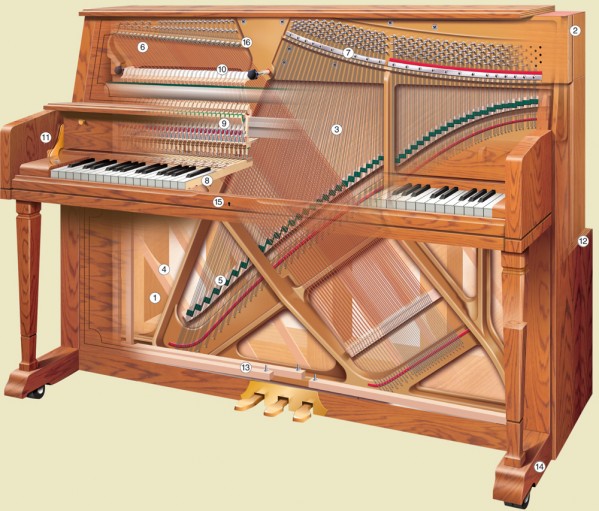
Acoustic Piano – also referred to as a ‘traditional piano,’ an acoustic piano’s sound comes from strings and a wood soundboard vibrating. Pressing the piano’s keys triggers hammers to strike metal strings when then vibrate. This energy is then transmitted through a bridge into the soundboard, which amplifies the sound. As pianos get taller or longer they accommodate longer strings and larger soundboards, making them louder and bass response deeper than the same brand and series of smaller piano. Types of acoustic pianos include:
Upright Pianos are designed to be placed against a wall for the best sound and take up less space than a grand piano. Before the 1940’s, upright pianos were marketed as ‘vertigrands,’ because the soundboard and action are installed in the pianos vertically as opposed to horizontally in grand pianos. Today, upright pianos are commonly referred to as ‘vertical’ pianos within the industry.
Console Pianos are upright pianos that either have no legs under the keys or have legs that hangs freely below the keys.
Studio Pianos are upright pianos that have legs under the keys that is attached at the bottom to the frame of the piano.
Spinet Pianos are upright pianos that have shorter keys and ‘drop-down actions’ that compromise the performance of the piano. No manufacturers build spinet pianos today.
Grand Pianos are based on the original design of the piano and range in size from just under 5 feet to 9 feet long. Grand pianos are sometimes called ‘baby grands’ or ‘parlor grands,’ although there is no difference. The largest grands, those roughly 9 feet and longer, are referred to as ‘concert grands.’
Acoustic Projection Sound System – enhances the sound quality of a digital piano by recreating the unique sound space that is created when you play an acoustic piano — the resonance between strings and the resonance from the piano’s frame or body. Realized through a complex and yet harmonious combination of elements. Through innovative Acoustic Projection technology, which marries the multidimensional sound system found in Roland’s flagship V-Piano Grand with their SuperNATURAL Piano sound engine. Acoustic Projection delivers its magic though a multi-channel speaker system, with each speaker located properly to project each sound element in its natural position. The sound elements from each speaker are intelligently blended to reproduce the true sound field of an acoustic piano.
Found on Roland HP-506, HP-508 & LX-15e pianos.
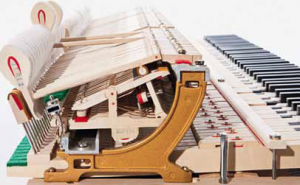
Action (#9)– comprised of more than 40 individual pieces for each key, the action in an acoustic piano transfers the energy from the player’s fingers to the strings, allowing a range from soft (piano) to loud (forte). Regulation of the action determines the ‘feel’ of a piano.
On the best piano, these complex mechanisms are made of high quality wood, with some felt and metal. Low quality pianos replace hardwood pieces with various plastic formulations including ABS Styran. How much and which parts are made of cheaper plastic can vary widely by manufacturer and model.
Quality all-hardwood actions are the most stable and reliable and offer the most control and touch for the player. Steinway & Sons, Boston, Essex, Pramberger, and Wm. Knabe & Co are among the most popular brands still using all-hardwood in their piano actions.
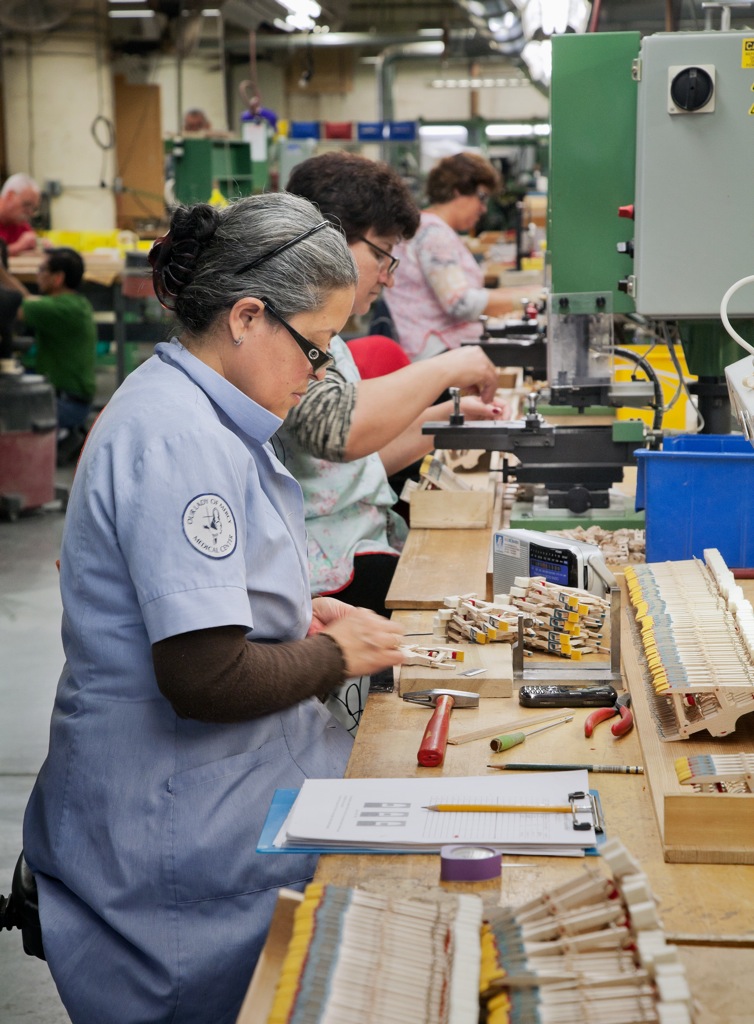
Steinway’s Permafree Accelerated Actions are still built by hand in New York.
Permafree Accelerated Action® – an action assembly build by combining hard-wood parts anchored to a Tubular Metallic Frame fitted with a hard maple interior dowel which is force-fitted at minimum moisture content for stability in every climate. The small, red bushings are made of felt impregnated with a proprietary solution that makes them more slick. With this design, there is less energy lost between the key and the hammer, giving the player far more control of the sound and color of the music.
Laboratory tests have proven that the keys on a Steinway piano repeat 13% more quickly than the keys of any other piano. The same features that allow for the faster repeat also provides a much more sensitive, responsive keyboard, an aspect that can be appreciated even by beginning pianists.
Permafree Accelerated Actions are found on all American-made Steinway grand pianos built after 1986.
Acrylonitrile butadiene styrene (ABS) – a common thermoplastic commonly used in low-end piano actions. ABS Styran is sometimes mixed with carbon, which changes the color from a milky-white to black.
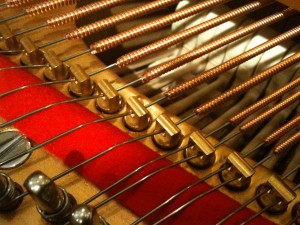
Agraffes (#16) – a string guide, similar to the pressure bar, for bass strings. Found in most larger, higher quality upright pianos and all good quality grand pianos. (also see image to the right)
Authentic Fortepiano Tones – Masterpieces composed by maestros such as Mozart, Beethoven, and Chopin can be played with the original sounds from the period on digital pianos with this technology. The appreciation and understanding for the piece is heightened when using the instrument that was actually used by the composers. You can also play these early piano sounds with built-in historic temperaments which are ideal to play with other classical instruments. Found on all current Roland HP-503, HP-505, HP-507 & LX-15 Digital Pianos.
Backposts (#1) – serve as a reinforcement in quality pianos. You would actually see these from behind an upright piano.
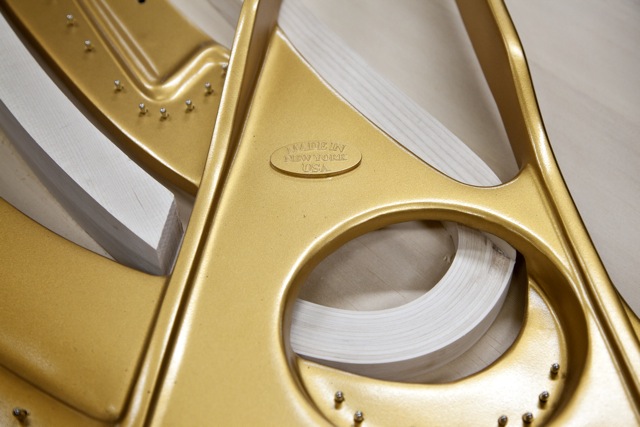
Bridge is sandwiched between the soundboard and plate in a Steinway piano before it has been strung. Click for more detail. Photo by Chris Payne.
Bridge (#5) – In all string instruments, the bridge transfers energy from the strings to the soundboard. Unlike the soundboard, piano bridges will be made out of hardwoods, the best quality wood being maple.
Smaller pianos will refer to having multiple bridges because the area is too small for the single bridge to make the ‘loop’ from the bass section to the strings below. Manufacturers work around this by making two separate bridges; one for the bass and one for the rest of the piano. A piano that has one bridge is not necessarily better than one with two bridges, it is simply a matter of design and size.
- Vertically laminated bridges are created by laminating layers of hardwood – usually maple – and capping the bridge with another piece of maple. This allows for more efficient and pure sound transfer and a longer last bridge.
Cabinet Locks (#15) – a popular feature in institutional style pianos used to lock the fallboard and lid.
Case (#12) – laminated pieces of solid wood or engineered wood (depends on the brand and model) built around the piano structure. Cases are typically available in a variety of finishes including ebony, mahogany, cherry and walnut and a variety of sheen, like high polish, satin luster and satin.
Castors (#14) – allow a piano to be more easily moved a short distance. Pianos should always be moved by professionals distances of more than a few feet and extreme caution should be used when repositioning a piano with free-hanging legs.
Digital Piano – Looking similar to a spinet, digital pianos rely on electronics and sophisticated recordings called samples to reproduce the sound of an acoustic piano through speakers. Since they do not have hammers, strings, soundboards or plates, they weigh much less than traditional pianos and never need to be tuned.
Duplex Scale – provides a clearer sound to each note in an acoustic piano by fine tuning the ends of the piano’s strings. Most commonly found in higher quality grand pianos.
Fallboard (#11) – the case piece that closes over the keys.
Hammers (#10) – swung by the action into the strings to cause the strings to vibrate and make sound.
Hybrid Piano – These will have elements of digital pianos and acoustic pianos blended together. There are two types of hybrid pianos:
- Digital Only – Hybrids like the Yamaha AvantGrand use some acoustic piano action parts combined with digital piano sounds played through speakers.
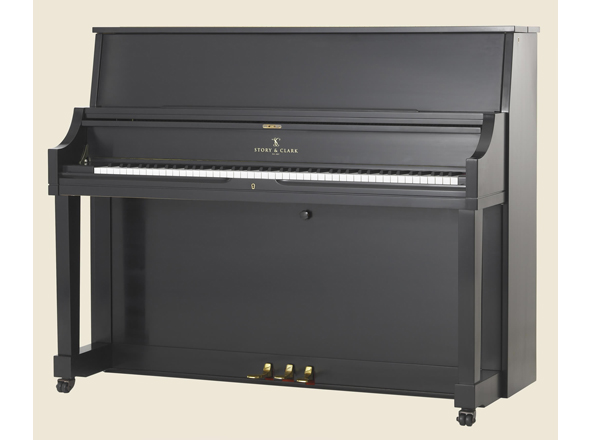
True hybrid pianos can either be played as an acoustic piano or a digital piano. Digital only hybrids like the Yamaha AvantGrand only offer digital sound and partial acoustic actions.
- True Hybrids – Like a Toyota Prius that uses batteries and a gasoline engine, true hybrid pianos like the Story & Clark have complete acoustic piano actions, strings, and soundboards but also have digital features and sounds played through speakers. These give the player the option of either playing a real acoustic piano or playing a digital piano with a real acoustic piano action through speakers or headphones.
Keys (#8) – simply put, the keys are the only way for the player to tell the piano what to do.
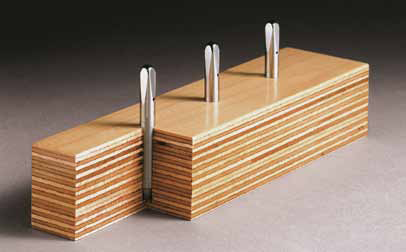
Sample of a laminated maple pinblock by Steinway & Sons in their Essex piano.
Pin Block (#2) – also referred to as ‘wrestplanks,’ laminated blocks of wood mounted under the plate that serve to grip the hundreds of tuning pins that hold the strings in proper pitch. Pin blocks can be made from any wood, including engineered woods, but the best quality blocks are made from maple. One of the most critical parts of a piano, pin block failure signals the end of the life of a piano. The condition of the pin block is one of the most important factors in purchasing any piano – especially used pianos as replacing a pin block will usually cost more than a new piano.
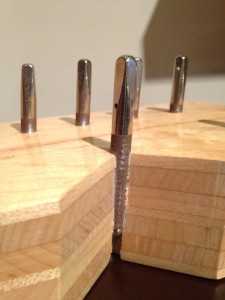
Cut-away model of the Steinway & Sons’ Hexagrip Wrestplank. Found in Genuine Steinway & Sons pianos beginning in 1963.
Hexagrip® Wrestplank – the patented (US patent 3091149) type of pin block used exclusively in Steinway & Sons pianos beginning in 1963.
Made entirely from seven thick, quarter-sawn maple planks for minimum glue content. This stronger and more stable block features wood layers aligned at 45 or 90 degrees from each other for maximum gripping power.
Because the Hexagrip design grips the pin tighter, ‘setting the pin’ when tuning is unnecessary, dramatically increasing the life of the Steinway & Sons piano’s strings as they are not over stretched each time the piano is tuned.
Octagrip® Pin Block – similar to the Steinway Hexagrip block, uses 11 layers of maple (8 to grip the pins and 3 more for added strength) alternating at 30 degree intervals instead of 7 layers alternating at 45 degrees.
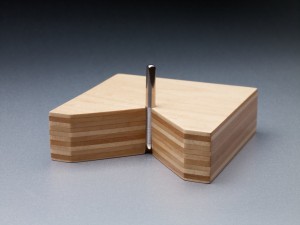
Sample of the Steinway designed Boston Piano Octagrip Pinblock, which offers longer life and increased tuning stability.
The Octagrip block is a more economical version of the Hexagrip block with similar benefits. This allowed Steinway & Sons to design a piano with similar tuning stability and string life to the Steinway, but at less than half the price.
Octagrip pin blocks are found exclusively in Boston “Performance Edition” pianos designed by Steinway & Sons built after 2011.
Plate – made of heavy iron, the plate holds the tension of the strings and stabilizes the piano. Sometimes mistakenly referred to as ‘harps,’ plates in higher quality pianos are sandcast while lower quality pianos use vacuum processed plates.
Pressure Bar (#7) – guides the strings into place for more stability and clear tone.
Progressive Damper Action Pedal a digital piano feature that gives light resistance at the beginning of the stroke and more resistance the instant they begin to take effect, just like real acoustic pianos. This makes it easy for the performer to know when the pedal begins take effect, and also allows half-pedal techniques for subtle control of aftertones and resonance. This pedal can accurately convey the techniques of serious pianists. Found on all current Roland HP Series Digital Pianos.
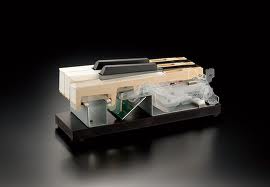
Roland PHA4 Digital Piano Action is more responsive than most new upright and many new and used grand pianos.
Progressive Hammer Action Keyboards – state-of-the-art key actions that are built into today’s best quality digital pianos. PHA actions are modeled after high quality grand pianos and offer more accurate touch than most upright acoustic pianos.
- PHA Ivory Feel Keyboard – A ‘compact’ version of the digital piano progressive hammer action found in the affordable Roland RG series and more similar to actions found in other brand’s higher end models. Found on the Roland RP-301R Digital Piano.
- PHA-4 Premium Ivory Feel Keyboard – With the same progressive hammer action and escapement as the top-line PHA III, it offers expression and performance that’s perfect for beginning through intermediate players. The surface of white keys replicates the unique appearance and comfortable feel of real ivory keys. The keys are constructed of a one-piece proprietary material that provides excellent moisture absorbency. Found on the Roland HP-504 Digital Piano.
- PHA-4 Concert Ivory Feel Keyboard – the world’s most sensitive and fastest key-repetition for digital pianos, these keyboards faithfully translates into sound the subtle differences in tones from different playing styles and force at which they are played. The keys are finished with material that provides moisture-absorbing properties, resulting in a keyboard with the natural texture and tactile sensation of real ivory and ebony. Found on all Roland HP-506 , HP-508 & LX-15e Digital Pianos.
Ribs (#4) – glued to the soundboard to create the crown the soundboard toward the bridges. Separating ribs are a common cause of loss of soundboard crown.
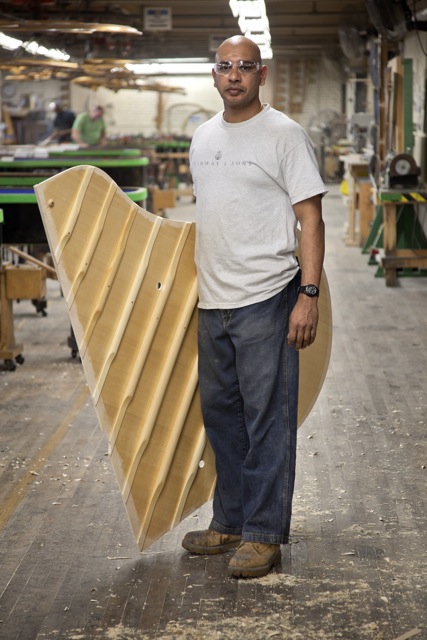
A worker at the Steinway & Sons factory in New York holds a soundboard – exposing the ribs – before it is installed in a piano.
Soundboard (#3) – considered the heart and soul of a piano, the soundboard serves as the amplifier and speaker in an acoustic piano. Most piano soundboards are made of spruce, although the variety and grade vary significantly from brand to brand and sometimes even within the same brand.
- Tapered soundboards are made of higher quality spruce and are thinner at the edges than in the middle, allowing the board to capture the energy from the strings and amplify more efficiently. A smaller piano with a tapered soundboard will sound more full and deep as a larger piano with a standard board. Boston, Essex, Pramberger and Wm. Knabe are examples of brands that use tapered soundboards in their new pianos.
- Diaphragmatic soundboards are similar to tapered boards, except they are more exact. Thinner at the edges, these boards are shaped like a diaphragm and are thicker where the bridges are attached for even more efficiency and purity of sound. Steinway & Sons patented the diaphragmatic soundboard in 1936 (a second patent was issued in 1937) and continues to use this technology in their new pianos.
Strings (#6) – hundreds of different length and thickness of string are struck by the hammers to create tone. Different brands and grades of string will play a part in determining the sound of a piano.
SuperNATURAL Piano Engine – technology that gives a digital piano seamless velocity response, natural note decay, and authentic key-range behavior to reproduce perfect piano sound and expression. Tone color changes seamless in response to touch, accurately translating the player’s emotions. Tone decay is natural and organic, with the decaying sound not only decreasing in volume, but also gradually changing in color to a softer tone. Each note has its own character, which creates variations in tonal color and resonance of each note. Found on all current model Roland Digital Pianos.
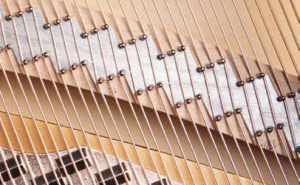 Tension – The tension design determines the sound of a piano as well as how long it will last. There are two types of piano design:
Tension – The tension design determines the sound of a piano as well as how long it will last. There are two types of piano design:
- Lower Tension Design pianos are the most popular for sound and last the longest. By using a more efficient soundboard and action, less tension is put on the strings and the piano as a whole is more stable. Lower Tension Design pianos are described as having a ‘richer’ or ‘fuller’ sound with longer decay and sustain. Lower Tension pianos also have a greater range from the softest (pianissimo) to loudest (fortissimo). Steinway & Sons, Boston, Essex, and Pramberger are examples of Lower-Tension pianos.
- Higher Tension Design pianos are louder than Lower Tension designs and are characterized as ‘bright,’ ‘muddy,’ or ‘glassy.’ By increasing the tension on the strings, these pianos play louder but have less decay and sustain and are less dynamic (range from pianissimo to fortissimo). Because of the higher tension, the strings, pin blocks and frames are under much more stress, leading to about half the usable lifespan of similarly priced Lower Tension pianos. Yamaha, Kawai, and Schimmel are examples of high tension pianos.
Trap Assembly (#13) – connect piano pedals to up to three different mechanisms. Most common are sustain/damper on the right, unicorda or soft on the left, and sostenuto, bass sustain or mute in the middle.